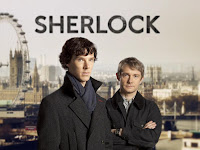I make a lot of spoofs. Fact.
I love being able to take an idea, and then develop it and make it into something different; something unique. It is often true that there are no new ideas, that someone will have probably thought of it before you have, which is why it is important to be original - the idea may not be, but your approach to it can. Sherlock is perhaps one of my most favourite TV series, and I love the opening titles. The editing and juxtaposition of the images is simply mind-blowing, the film accompanied by stop-motion animation and text.
Sherlock is perhaps one of my most favourite TV series, and I love the opening titles. The editing and juxtaposition of the images is simply mind-blowing, the film accompanied by stop-motion animation and text.You can watch it here: http://www.youtube.com/watch?v=1HsxGygknNE
I wanted to try and create my own version of the opening titles, with the idea that Sherlock becomes Shirley, and John becomes Joan (Shirley's cousin), even though the style is completely different. I didn't overlay images or use stop-motion in the film. In comparison, mine is relatively simple. I spent around 5 minutes figuring out what to film, and then went out and did it - a spur of the moment action.
I used my little Canon Ixus to film with, but set it to the miniature effect - which means it films everything at 10 times the speed. I set it to minature because I like the vivid colours and the blurs around the edges. When it came to editing it was quite difficult as everything had to be slowed down by at least 25% which made the images a bit jumpy - although to be honest I think its quite effective. Some of the shots were filmed more than once - with wide angles and close ups. The feet shots were filmed with the camera upside down on the tripod so I could run with it - a little odd you might think, but it worked. Here are some still shots:

The film was shot in just one location, so in that sense it is not as varied as it could have been. There could have been several locations, therefore allowing me to do more such as experimenting with juxtaposition and the like. All in all I am quite happy with how the film turned out. I could easily imagine it as the beginning to an episode, which - perhaps somewhere in the near future - I might just attempt to make.Fact: It is always important to take more footage than you need. More is always preferable to less.
Here is the finished video: https://vimeo.com/81215770
Comments
Post a Comment